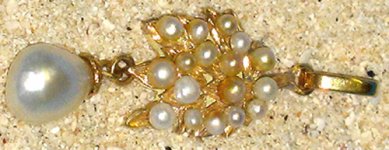That is the best decision yet. If that pearls turns out to be real, everything is good.
The empty space near the bottom just screams "pocket" such as can form at the edge of a bead nuked pearl, making it necessary to rule out that possibility. If it is natural, then that pocket is highly unusual, because naturals don't have such gaps. There is no reason for them to form. The pocket exactly matches the curve of a complete circle along the edge of the bead. A circle that fits inside the pearl just as a bead would.
Bead nuked pearls are mostly found growing in the gonad, not the mantle, where most natural pearls are formed. Your divers need to get it photoed before removing it from the mollusk.
But a fair number of bead nuked pearls are ones divers already have or traded for, so they come out of family collections and are not recent finds. This could be why all the mustikas showed up in Budi's first pictures.
We have had plenty of discussions on this forum of what mustikas are- and are not. They definitely are not real pearls, they are manufactured pearls symbolizing a metaphorical attribute. Every animal mustika tested so far, is made out of glass or some other material that shows human workmanship under a microscope. I am not criticizing mustikas; when it is known that is what they are, it is a beautiful tradition.
One thing, the nacre is very thick on the contested pearl. That makes it better quality than the average bead nuked pearl.

